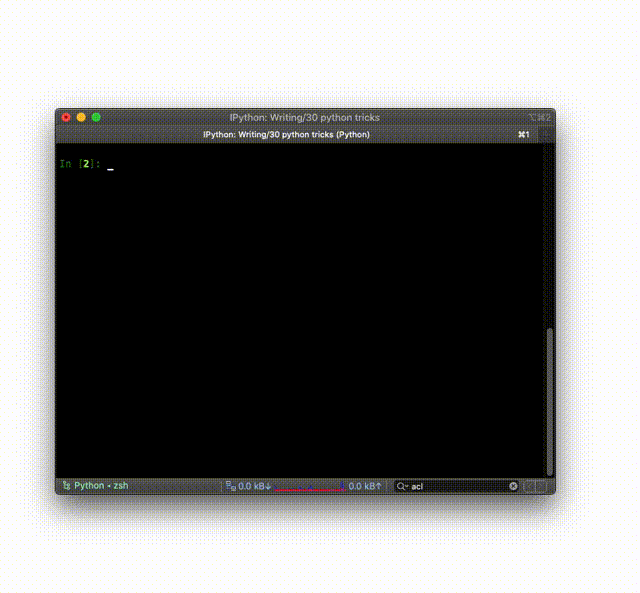Improve your Python knowledge and skills

With the holidays behind us, most of us have returned to our day jobs. For all those hard workers, here are 30 Python best practices, tips, and tricks. I’m sure they’ll help you procrastinate your actual work, and still learn something useful in the process.
In case you missed it: Python 2 is officially not supported as of January 1, 2020. This guide has a bunch of examples that only work in Python 3. If you’re still on Python 2.7, upgrade now.
If you’re on MacOS, you can use Homebrew to painlessly upgrade Python.
You can check for the Python version in your code, to make sure your users are not running your script with an incompatible version. Use this simple check:

IPython is basically an enhanced shell. It’s worth it just for the autocompletion alone, but there is much more. I like it too for all the magic commands that are built-in. Here are a few :
%cd— to change the current working directory%edit— to open an editor and execute the code you typed in after closing the editor%env— to show the current environment variables%pip install [pkgs]— to install packages without leaving the interactive shell%timeand%timeit— to time the execution of Python code
Read the full list here.
Another useful feature is referencing the output of a previous command. In and Out are actual objects. You can use the output of the 3rd command by using Out[3].
Install IPython with:
pip3 install ipython
A list comprehension can replace ugly for loops used to fill a list. The basic syntax for a list comprehension is:
[ expression for item in list if conditional ]A very basic example to fill a list with a sequence of numbers:
And because you can use an expression, you can also do some math:
Or even call an external function:
And finally, you can use the ‘if’ to filter the list. In this case, we only keep the values that are dividable by 2:
With sys.getsizeof() you can check the memory usage of an object:
Woah… wait… why is this huge list only 48 bytes?
It’s because the range function returns a class that only behaves like a list. A range is a lot more memory efficient than using an actual list of numbers.
You can see for yourself by using a list comprehension to create an actual list of numbers from the same range:
Functions in Python can return more than one variable without the need for a dictionary, a list or a class. It works like this:
This is alright for a limited number of return values. But anything past 3 values should be put into a (data) class.
Since version 3.7, Python offers data classes. There are several advantages over regular classes or other alternatives like returning multiple values or dictionaries:
- a data class requires a minimal amount of code
- you can compare data classes because
__eq__is implemented for you - you can easily print a data class for debugging because
__repr__is implemented as well - data classes require type hints, reduced the chances of bugs
Here’s an example of a data class at work:
An in-depth guide can be found here.
A neat little trick that can save a few lines of code:
Since Python 3.5, it became easier to merge dictionaries:
If there are overlapping keys, the keys from the first dictionary will be overwritten.
This is just one of those lovely gems:
You can split a string into a list of strings. In this case, we split on the space character:
And vice versa from the previous trick, create a string from a list and put a space character between each word:
If you were wondering why it’s not mylist.join(" ") — good question!
It comes down to the fact that the String.join() function can join not just lists, but any iterable. Putting it inside String prevents implementing the same functionality in multiple places.

This one will either impress or repulse, depending on who’s looking. On a more serious note, this can come in handy especially when analyzing social media data.
First, install the emoji module:
pip3 install emojiWith this installed, you can do as follows:
Visit the emoji package page for more examples and documentation.
The basic syntax of list slicing is:
a[start:stop:step]Start, stop and step are optional. If you don’t fill them in, they will default to:
- 0 for
start - the end of the string for
end - 1 for
step
Here are some examples:
You can use the slice notation from above to reverse a string or list. By using a negative stepping value of -1, the elements are reversed:
I finally found a good excuse to include kittens in one of my articles! You, however, might use it to display graphs and such. First, install Pillow, a fork of the Python Image Library:
pip3 install PillowNow download this image to a file called kittens.jpg:

You can use the following code to display the image from your Python code:
Or you can do it right from IPython:

Pillow can do a lot more than displaying the image. It can analyze, resize, filter, enhance, morph, etcetera. See the documentation for all its features.
One of Python’s built-in functions is called map(). The syntax for map() is:
map(function, something_iterable)
So you give it a function to execute, and something to execute on. This can be anything that’s iterable. In the examples below I’ll use a list.
Take a look at your own code and see if you can use map() instead of a loop somewhere!
By creating a set with the set() function, you get all the unique elements from a list or list-like object:
To find the most frequently occurring value in a list or string:
Do you understand why this works? Try to figure it out for yourself before reading on.
You didn’t try, did you? I’ll tell you anyway:
max()will return the highest value in a list. Thekeyargument takes a single argument function to customize the sort order, in this case, it’s test.count. The function is applied to each item on the iterable.test.countis a built-in function of list. It takes an argument and will count the number of occurrences for that argument. Sotest.count(1)will return 2 andtest.count(4)returns 4.set(test)returns all the unique values from test, so {1, 2, 3, 4}
So what we do in this single line of code is take all the unique values of test, which is {1, 2, 3, 4}. Next, max will apply the list.count function to them and return the maximum value.
And no — I didn’t invent this one-liner.
You can create your own progress bar, which is fun to do. But it’s quicker to use the progress package:
pip3 install progress
Now you can create a progress bar with minimal effort:
The following animation demonstrates all the available progress types:

You can obtain the result of the last expression with the underscore operator, e.g. in IPython this looks like:
In [1]: 3 * 3
Out[1]: 9In [2]: _ + 3
Out[2]: 12
This works in the Python shell too. In addition, the IPython shell allows you to use Out[n] to get the value of the expression In[n]. E.g., Out[1] would give us the number 9 in the example above.
You can quickly start a web server, serving the contents of the current directory:
python3 -m http.serverThis is useful if you want to share some stuff with a co-worker or want to test a simple HTML site.
Although you can use triple quotes to include multi-line strings in your code, it’s not ideal. Everything you put between the triple quotes becomes the string, including the formatting, as you can see below.
I prefer the second way, which concatenates multiple lines together, allowing you to format your code nicely. The only downside is that you need to explicitly put in newlines.
This is another one of those ways to make your code more concise while still keeping it readable:
[on_true] if [expression] else [on_false]As an example:
x = "Success!" if (y == 2) else "Failed!"You can use Counter from the collections library to get a dictionary with counts of all the unique elements in a list:
You can chain comparison operators in Python, creating more readable and concise code:

With Colorama, you can add some color to your terminal.
The python-dateutil module provides powerful extensions to the standard datetime module. Install it with:
pip3 install python-dateutil You can do so much cool stuff with this library. I’ll limit the examples to just this one that I found particularly useful: fuzzy parsing of dates from log files and such.
Just remember: where the regular Python datetime functionality ends, python-dateutil comes in!

In Python 2, the division operator ( / ) defaults to an integer division, unless one of the operands is a floating-point number. So you have this behavior:
# Python 2
5 / 2 = 2
5 / 2.0 = 2.5In Python 3, the division operator defaults to a floating-point division and the // operator has become an integer division. So we get:
Python 3
5 / 2 = 2.5
5 // 2 = 2For the complete motivation behind this change, you should read PEP-0238.
You can use the chardet module to detect the charset of a file. This can come in very useful when analyzing big piles of random text. Install with:
pip install chardet
You now have an extra command-line tool called chardetect, which can be used like this:
chardetect somefile.txt
somefile.txt: ascii with confidence 1.0You can also use the library programmatically, check out the docs.
